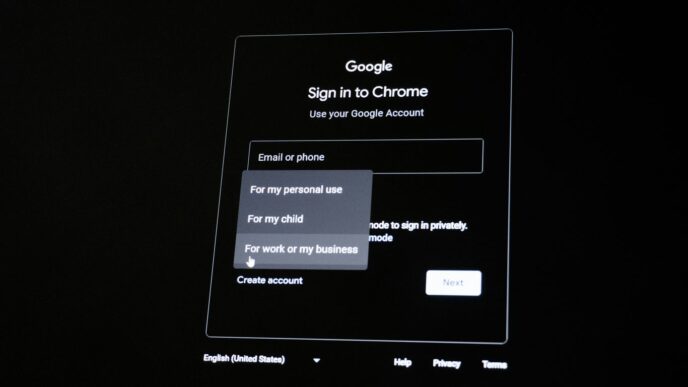The way we talk to computers is changing, and it’s happening fast. AI chat technology is at the heart of this shift, making our interactions with machines more natural and helpful. It’s like having a smart assistant ready to go, whether you need help with a quick question or a more complex task. This technology is already making waves, and it’s only going to become more important as we move forward. Let’s take a look at how ai chat is shaping our world.
Key Takeaways
- AI chat is moving beyond simple answers to understand context and remember past conversations, making interactions feel more human.
- These advanced systems are improving customer service by offering personalized help and making it easier for people to get what they need.
- Future AI chat will involve more than just text, incorporating voice and even visuals for richer communication experiences.
- AI chat is breaking down language barriers and is available around the clock, making communication easier for everyone, everywhere.
- From healthcare to shopping, AI chat is finding new ways to be useful, helping with everything from learning to making smart purchases.
The Evolving Landscape of AI Chat
The way we talk to computers has changed a lot, and AI chat is right in the middle of it. It’s moved way past those old, clunky systems that just followed a script. Now, we’re talking about AI that can actually understand what you’re saying, remember it, and talk back in a way that feels pretty natural. It’s pretty wild when you think about it.
From Simple Scripts to Sophisticated Systems
Remember those early chatbots? They were basically just fancy if-then statements. You’d type something, and if it matched a keyword, you’d get a pre-written answer. It was okay for basic questions, but that was about it. Now, AI chat systems are built on much more complex ideas. They can handle conversations that go back and forth, picking up on details you mentioned earlier. It’s like the difference between talking to a vending machine and talking to a helpful store clerk.
The Role of Machine Learning and NLP
So, how did we get here? A big part of it is machine learning and Natural Language Processing (NLP). Machine learning lets these AI systems learn from huge amounts of text and conversations. They start to see patterns and figure out how language works, not just by rules, but by example. NLP is what helps them break down what we’re saying – understanding the words, the grammar, and even the intent behind them. This combination is what allows AI to move from just recognizing keywords to actually understanding meaning.
Context-Aware Interactions and Memory
One of the biggest leaps forward is context awareness. Older bots would forget everything as soon as you asked a new question. Today’s AI chat can keep track of the conversation. If you ask about a product, then later ask, "What colors does it come in?", the AI knows you’re still talking about that same product. This ability to remember and use past information makes the whole experience much smoother and more helpful. It’s like having a conversation with someone who’s actually paying attention.
Transforming User Experiences with AI Chat
AI chat is really changing how we interact with technology, making things smoother and more helpful. It’s not just about answering questions anymore; it’s about creating a better overall experience for everyone using it.
Enhancing Customer Service and Engagement
Think about calling a company. Usually, you’re stuck waiting on hold, right? AI chat changes that. Chatbots can jump in right away, answering common questions or guiding you to the right place. This means you get help faster, and the company can handle more people without needing a huge support team. It’s a win-win. Plus, these bots can be programmed to sound like your brand, so the interaction feels consistent with the company’s image. They can handle everything from simple ‘where’s my order?’ questions to more involved troubleshooting, making sure people get the info they need without a long wait.
Personalized Recommendations and Support
AI chat goes beyond just answering questions. It can actually learn what you like. For example, when you’re shopping online, a chatbot might suggest items based on what you’ve looked at before or what similar customers have bought. This makes finding what you need much easier and can even introduce you to things you wouldn’t have found otherwise. It’s like having a personal shopper available anytime. This kind of tailored help makes the whole experience feel more personal and less like a generic interaction.
Seamless Integration Across Platforms
One of the best things about AI chat is how it can show up everywhere you are. You might start a chat on a company’s website, then get a follow-up message on their app, or even through a social media platform. This makes it super convenient because you don’t have to switch between different tools or remember where you left off. The conversation just follows you. This constant availability means help or information is always just a click or a tap away, which really cuts down on frustration and makes people happier with the service they receive.
Expanding Horizons: Future Trends in AI Chat

So, what’s next for AI chat? It’s not just about making bots smarter; it’s about making them more human-like and useful in ways we’re only starting to imagine. The tech is moving fast, and a few big ideas are shaping where things are headed.
The Rise of Voice and Multi-Modal Interactions
Text is fine, but sometimes you just want to talk, right? That’s where voice comes in. We’re seeing more and more voice-enabled AI, like the assistants on our phones and smart speakers. But it’s not stopping there. Think about AI that can understand not just your words, but also what you’re showing it or how you’re gesturing. Imagine asking a bot to find a recipe, and then using your hands to flip through the pictures while you’re cooking. This mix of text, voice, and visuals – that’s multi-modal, and it’s going to make interacting with AI feel much more natural, almost like talking to another person.
Emotional Intelligence and Empathy in AI
This is a big one. Right now, most AI chat is pretty straightforward. It answers questions, it follows commands. But what if it could pick up on how you’re feeling? Future AI chat aims to understand emotions and respond with a level of empathy that feels genuine. This could change everything, especially in areas like mental health support or customer service where understanding the user’s mood is key. Imagine a bot that can sense you’re frustrated and adjust its tone, or one that can offer comfort when you’re feeling down. It’s a complex challenge, but the progress being made is pretty remarkable.
Integration with Augmented and Virtual Reality
This is where things get really sci-fi, but it’s closer than you think. AI chat is starting to blend with AR and VR. Picture this: you’re trying to assemble some furniture, and an AI assistant, overlaid on your view through AR glasses, guides you step-by-step, pointing out exactly where each screw goes. Or maybe you’re exploring a new city virtually, and an AI guide pops up in your VR headset to tell you about the sights. This combination creates incredibly immersive experiences, making AI chat a partner in everything from learning new skills to exploring digital worlds.
AI Chat’s Global Reach and Accessibility
It’s pretty wild how AI chat can connect people all over the world, right? Gone are the days when you needed a whole team of people speaking different languages to talk to customers everywhere. AI chat just… does it. This technology breaks down borders, making communication easier than ever before. Think about it: a small business in, say, Ohio can now chat with someone in Japan about their products without missing a beat. That’s a huge deal for growth.
Breaking Down Language Barriers
This is probably the most obvious win. AI chat can translate conversations on the fly. So, if someone types in Spanish, the AI can understand it and respond in English, or whatever language the user prefers. It’s like having a universal translator built right into your website or app. This means more people can understand what you’re offering, and you can understand them too. It really opens up markets that might have been too difficult to reach before.
24/7 Availability Across Time Zones
Another big plus is that AI chat never sleeps. It doesn’t matter if it’s 3 AM in your time zone; the AI is there, ready to help a customer in another part of the world. This constant availability is a game-changer for customer service. People don’t have to wait until business hours to get an answer to a simple question. They get help when they need it, which makes them happier customers.
Integration into Messaging and Social Media
AI chat isn’t just stuck on a website anymore. You can find it popping up in places you already hang out, like Facebook Messenger, WhatsApp, or even Instagram DMs. This makes it super convenient for users because they don’t have to go to a separate website to get help. They can just ask their question right there in the app they’re already using. It feels more natural and less like a chore to get information or support.
Innovative Applications of AI Chat Technology
AI chat is really starting to show up in all sorts of places, not just for answering simple questions. It’s becoming a tool that businesses are using in pretty creative ways to connect with people, figure out what customers want, and even help with marketing.
Revolutionizing Healthcare and Education
Think about healthcare for a second. AI chat can help people get quick answers about symptoms or understand treatment options without having to wait for an appointment. It can also offer support, which is a big deal when someone is feeling unwell or anxious. In education, these tools can act like personal tutors, helping students with homework or explaining tough concepts. They can even help teachers by handling some of the administrative tasks, freeing them up to focus more on teaching. It’s like having an extra assistant available anytime.
Empowering Finance and E-commerce
In the world of money, AI chat is making things easier too. You can ask your bank’s chatbot about your account balance, see your transaction history, or even get basic financial advice. For online shopping, it’s a game-changer. Chatbots can suggest products you might like based on what you’ve looked at before, answer questions about items, and even help you through the checkout process. This makes shopping quicker and less of a hassle.
Driving Marketing Strategies and Insights
AI chat is also a goldmine for marketers. By looking at the conversations people have with chatbots, companies can learn a lot about what customers like and don’t like. This information is super useful for making marketing campaigns better and improving the overall customer experience. Plus, some AI chat tools can even help create marketing content or simulate different customer interactions, making campaigns more engaging and personal. It’s a smart way to get ahead.
The Future of Human-AI Collaboration

It’s pretty wild to think about how AI is changing from just a tool into something more like a partner. We’re moving past the old sci-fi ideas of AI taking over and heading towards a future where humans and AI work together. As AI gets better at understanding us, even our feelings, it’s becoming less of a gadget and more of a helpful friend. This shift makes you wonder how AI will change our relationships with technology, and maybe even with each other.
Bridging the Gap Between Humans and Machines
Think about how AI can help people who might need a bit more support. For older folks or those dealing with memory issues, AI chatbots can be a real help. They can remind people about taking their medicine, help keep track of daily tasks, or just be there for a chat. By picking up on emotions and responding in a caring way, AI has the potential to make people feel more connected and less alone. It’s not about replacing human contact, but about adding another layer of support where it’s needed.
AI as a Supportive Ally
AI is getting smarter about remembering what we’ve talked about before. This means future conversations will feel more natural, like talking to someone who actually knows you. Imagine an AI that remembers your favorite things or past requests, making interactions smoother. This kind of personalized help is showing up everywhere, from customer service to getting advice.
Here’s a look at how AI is becoming a better ally:
- Personalized Assistance: AI can tailor its responses based on your history and preferences.
- Routine Management: Helps with daily tasks like reminders for appointments or medication.
- Information Access: Provides quick answers and information without you having to search extensively.
- Companionship: Offers conversation and interaction, especially beneficial for those who are isolated.
Ethical Considerations for Responsible AI
As AI becomes more common, we have to be smart about how we use it. Things like keeping our personal information safe and not becoming too reliant on AI are big topics. Even though AI can do amazing things, we need to make sure it’s used in ways that are good for people. It’s a balancing act – pushing the boundaries of what AI can do while also being careful and responsible. We need to think about the rules and guidelines to make sure AI helps us all out, without causing new problems.
The Road Ahead
So, where does all this leave us? It’s pretty clear that AI chat isn’t just a passing trend; it’s really changing how we talk to computers and each other. We’re seeing bots get smarter, understand us better, and even start to get our feelings. This means better customer service, more helpful tools for learning, and maybe even new ways to connect with people. It’s exciting to think about what’s next, but it also means we need to keep up. Businesses that start using these tools now will likely do much better down the line. It’s not just about staying competitive; it’s about making things easier and more helpful for everyone involved. The future of talking with technology is here, and it’s only going to get more interesting.














